Digital Posters
Multimodal fMRI & Physiology
ISMRM & SMRT Annual Meeting • 15-20 May 2021

| Concurrent 3 | 19:00 - 20:00 |
3382.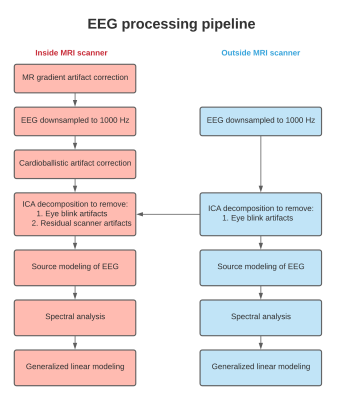 |
Pipeline for processing EEG data acquired during block-design simultaneous EEG-fMRI-ASL study
Balu Krishnan1, Wanyong Shin2, Ajay Nemani2, Anna Crawford2, and Mark Lowe2
1Epilepsy Center, Cleveland Clinic Foundation, CLEVELAND, OH, United States, 2Mellen Center, Cleveland Clinic Foundation, CLEVELAND, OH, United States
EEG data acquired during simultaneous EEG-fMRI studies are prone to environmental and physiological artifacts. In this study, we detail an EEG artifact reduction pipeline for a block design task paradigm during a BOLD/ASL sequence. Briefly, the pipeline consists of removal of MR and cardioballistic artifact, ICA based correction for removing eyeblink and residual scanner artifacts, and source modeling of EEG data to remove additional artifacts. Pipeline was tested on 7 subjects (6 multiple sclerosis patients and 1 normal-control). The EEG data processed using the pipeline shows high fidelity and is comparable to similar data acquired outside the scanner.
|
|||
3383.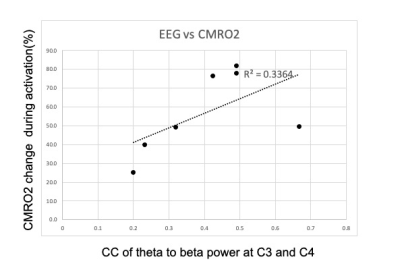 |
Are BOLD signal amplitude and synchronous low frequency fluctuations of EEG power related?
Wanyong Shin1, Balu Krishnan2, Ajay Nemani1, Anna Crawford1, and Mark J Lowe1
1Radiology, Cleveland Clinic, Cleveland, OH, United States, 2Epilepsy, Cleveland Clinic, Cleveland, OH, United States
Resting state motor network is investigated using EEG theta to beta ratio (TBR) and compared with calibrated fMRI.
|
|||
3384.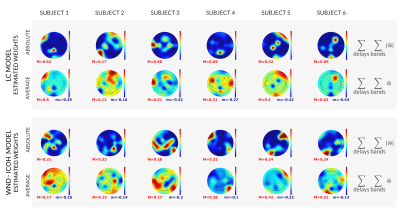 |
Deriving an EEG model to predict the activity of the default mode network measured by fMRI
Marta Xavier1, Inês Esteves1, Athanasios Vourvopoulos1, Ana R Fouto1, Amparo Ruiz-Tagle1, Raquel Gil-Gouveia2, and Patrícia Figueiredo1
1Department of Bioengineering, Institute for Systems and Robotics, Lisbon, Portugal, 2Neurology Department, Hospital da Luz, Lisbon, Portugal
We investigated an integration strategy whereby relevant EEG features are extracted and linear models learnt so as to predict the Default Mode Network activity measured by simultaneous fMRI. We compared the performance of four models: root-mean-squared frequency (RMSF), total power (TP), linear combination of band-specific power (LC), and weighted degree of the functional connectivity network built from the band-specific imaginary part of coherency of the EEG cross-spectrum (WD-ICoh). Models were estimated using elastic net regularization and were found to predict the target BOLD signal with fairly good correlations. Although these varied significantly across models, WD-ICoh outperformed the remaining models.
|
|||
3385.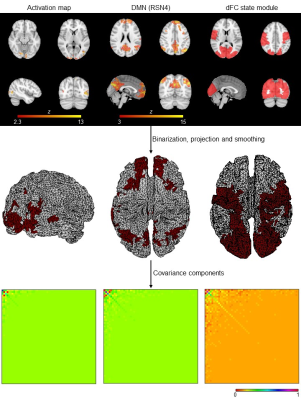 |
Optimizing EEG source reconstruction with concurrent fMRI-derived spatial priors
Rodolfo Abreu1, Júlia F. Soares1, Sónia Batista2,3, Lívia Sousa2,3, Miguel Castelo-Branco1,3, and João Valente Duarte1,3
1Coimbra Institute for Biomedical Imaging and Translational Research (CIBIT), Institute for Nuclear Sciences Applied to Health (ICNAS), University of Coimbra, Coimbra, Portugal, 2Neurology Department, Centro Hospitalar e Universitário de Coimbra, Coimbra, Portugal, 3Faculty of Medicine, University of Coimbra, Coimbra, Portugal
There is no consensus regarding the optimal EEG source reconstruction algorithm, nor a systematic comparison between sets of fMRI-derived spatial priors to be included in the inversion models. We compared four inversion algorithms, each with three sets of fMRI-derived spatial priors consisting of task activation maps, resting-state networks and, for the first time, dynamic functional connectivity states. We found that combining a beamformer with these priors improves the reconstruction quality, especially in terms of the overlap with task-related brain regions of interest and RSN templates. Our results may guide more informatively the selection of the optimal EEG source reconstruction approach.
|
|||
3386.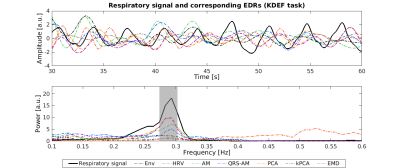 |
Evaluation of ECG-derived respiration signals in simultaneous EEG-fMRI acquisitions
Inês Esteves1, Ana R. Fouto1, Amparo Ruiz-Tagle1, Athanasios Vourvopoulos1, Marta Xavier1, Nuno A. Silva2, Raquel Gil-Gouveia3, Agostinho Rosa1, and Patrícia Figueiredo1
1ISR-Lisboa and Department of Bioengineering, Instituto Superior Técnico – Universidade de Lisboa, Lisbon, Portugal, 2Learning Health, Hospital da Luz, Lisbon, Portugal, 3Neurology Department, Hospital da Luz, Lisbon, Portugal
Physiological noise correction of the BOLD signal requires information concerning the cardiac and respiratory activity. For EEG-fMRI, the burden of performing extra recordings may be alleviated by retrieving an ECG-derived respiratory signal (EDR). This work aimed to evaluate different methods for EDR estimation and subsequent derivation of fMRI respiratory regressors, by comparison with the measured respiratory signal, for EEG-fMRI. The feasibility of EDR estimation was demonstrated, with KPCA and PCA methods achieving the best performance. Nevertheless, similarities between EDRs and respiration were not directly reflected by the regressors, and the impact of using EDR-based respiratory regressors should be further examined.
|
|||
3387.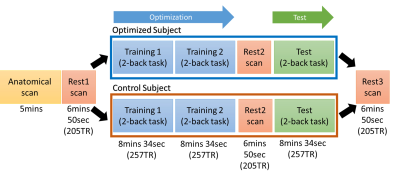 |
Closed-Loop tACS-fMRI: Online Optimization of tACS Stimulation to Enhance Fronto-parietal Connectivity
Beni Mulyana1,2, Aki Tsuchiyagaito1, Jared Smith1, Masaya Misaki1, Samuel Cheng2, Martin Paulus1, Hamed Ekhtiari1, and Jerzy Bodurka1
1Laureate Institute for Brain Research, Tulsa, OK, United States, 2Electrical and Computer Engineering, University of Oklahoma, Tulsa, OK, United States
We designed a closed-loop concurrent transcranial alternating current stimulation and functional MRI (tACS-fMRI) to optimize fronto-parietal fMRI connectivity. Capacity for modulating fMRI connectivity are highly dependent on the transcranial electric stimulation (tES) parameters such as electric current frequency and phase. We proposed closed-loop tACS-fMRI optimization to search and find the tACS parameters resulting in the highest frontoparietal connectivity. Comparing to control group, experimental group shows an increased task-related frontoparietal functional connectivity (FC) during the training runs. The improvements in working memory was observed in participants in experimental tACS group (testing vs baseline run, 2-back task).
|
|||
3388.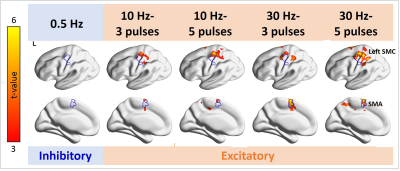 |
Functional MRI of the excitatory and inhibitory neuromodulations by transcranial magnetic stimulation at the human sensorimotor cortex
Hsin-Ju Lee1,2, Mikko Nyrhinen3, Risto J. Ilmoniemi3, and Fa-Hsuan Lin1,2,3
1Physical Sciences Platform, Sunnybrook Research Institute, Toronto, ON, Canada, 2Department of Medical Biophysics, University of Toronto, Toronto, ON, Canada, 3Department of Neuroscience and Biomedical Engineering, Aalto University, Espoo, Finland
We measured fMRI signals in response to excitatory and inhibitory TMS modulations over the human primary motor cortex (M1) with TMS bursts of high (10- and 30-Hz) and low frequency (0.5-Hz) with a controlled TMS dosage over the 30-s interval, respectively. Excitatory and inhibitory modulations were evidenced by motor evoked potential changes. Significantly increased fMRI signal at M1 was only detected under excitatory high-frequency TMS but not during inhibitory low-frequency TMS. The supplementary motor area (SMA) had significant fMRI signal changes after both kinds of TMS. The topology of the activated M1 and SMA matched those during the voluntary movement.
|
|||
3389.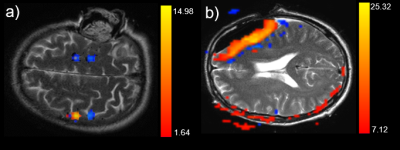 |
Intraoperative arterial spin labeling (iASL) reliably depicts functional networks during neurosurgery
Thomas Lindner1, Hajrullah Ahmeti2, Michael Helle3, Olav Jansen4, Michael Synowitz2, and Stephan Ulmer4,5
1University Hospital Hamburg-Eppendorf, Hamburg, Germany, 2Neurosurgery, University Hospital Schleswig-Holstein, Kiel, Germany, 3Tomographic Imaging Department, Philips Research Laboratories, Hamburg, Germany, 4Department of Radiology and Neuroradiology, University Hospital Schleswig-Holstein, Kiel, Germany, 5Radiology, Kantonsspital Winterthur, Winterthur, Switzerland
Using EPI Arterial Spin Labeling, resting state networks can be mapped during neurosurgery without an additional acquisition of a BOLD scan.
|
|||
3390.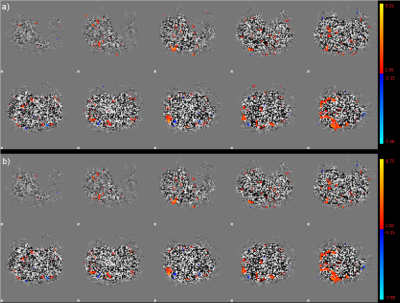 |
Visualizing Resting State Networks using Arterial Spin Labeling– Investigating the influence of Label and Control datasets
Thomas Lindner1, Michael Helle2, Olav Jansen3, and Stephan Ulmer3,4
1University Hospital Hamburg-Eppendorf, Hamburg, Germany, 2Tomographic Imaging Department, Philips Research Laboratories, Hamburg, Germany, 3Department of Radiology and Neuroradiology, University Hospital Schleswig-Holstein, Kiel, Germany, 4Radiology, Kantonsspital Winterthur, Winterthur, Switzerland In this study, the effects of separating the label and control condtion from an Arterial Spin Labeling dataset used for resting state mapping was investigated and no differences between the label and the control condition could be found. |
|||
3391.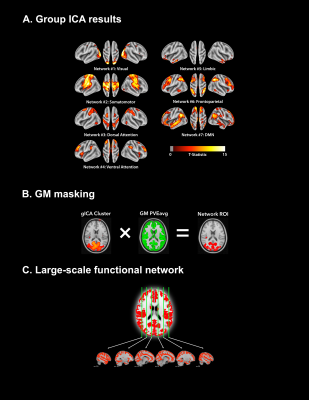 |
Assessing intersubject BOLD synchronization and BOLD-CBF coupling using movie fMRI
Kaden T Shearer1, Allen A Champagne2, Nicole S Coverdale1, Ingrid S Johnsrude3, and Douglas J Cook4
1Centre for Neuroscience Studies, Queen's University, Kingston, ON, Canada, 2Department of Medicine, Queen's University, Kingston, ON, Canada, 3The Brain and Mind Institute, University of Western Ontario, London, ON, Canada, 4Department of Surgery, Queen's University, Kingston, ON, Canada
Movie fMRI is a promising alternative to resting state paradigms given its ability to evoke predictable patterns of neuronal activation. However, it remains unknown whether increased reliability of cortical activation is accompanied by increased correlation between the BOLD and CBF signals (BOLD-CBF coupling). This study compared the intersubject synchronization of the BOLD signal across 7 functional brain networks between resting state and movie fMRI, as well as potential differences in BOLD-CBF coupling. Movie fMRI significantly improved the reliability of cortical activation between subjects compared to resting state, although no significant differences in BOLD-CBF coupling were documented.
|
|||
3392.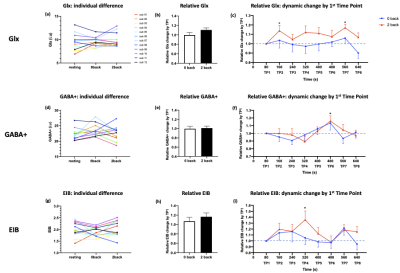 |
Dynamic neurometabolic and functional changes in the dorsolateral prefrontal cortex in a working memory: a combined 1H fMRS and fMRI study
Hyerin Oh1,2, Ben Babourina-Brooks1,2,3, Adam Berrington2,3, Dorothee P Auer1,2,3, Henryk Faas1,2, and JeYoung Jung4
1Division of Clinical Neuroscience, School of Medicine, University of Nottingham, Nottingham, United Kingdom, 2Sir Peter Mansfield Imaging Centre, University of Nottingham, Nottingham, United Kingdom, 3NIHR Nottingham Biomedical Research Centre, Queen’s Medical Centre, University of Nottingham, Nottingham, United Kingdom, 4School of Psychology, University of Nottingham, Nottingham, United Kingdom
Dynamic changes in Glx [glutamate + glutamine] and GABA concentrations were investigated in the dorsolateral prefrontal cortex (DLPFC) during a working memory using fMRS and fMRI at 3T. During the 12 minutes 2-back task Glx showed the trend of increase, while GABA levels remained stable. fMRI confirmed the increased regional activity in the DLPFC during 2-back vs. 0-back task. Importantly, the Glx changes were correlated with the DLPFC BOLD regional activity and task performance during 2-back task. Our results suggest that working memory related Glx changes may be involved in the DLPFC’s functional response and performance in working memory.
|
|||
3393.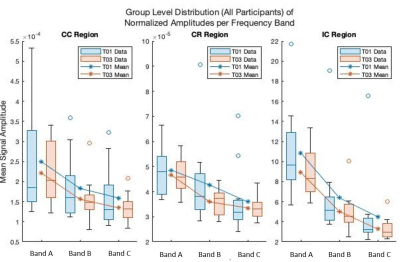 |
WM motor learning can be detected using low frequency oscillations in time series functional MRI
Tory Frizzell1, Elisha Phull2, Mishaa Khan2, Jodie Gawryluk3, Xiaowei Song2, and Ryan C.N. D'Arcy4
1Engineering Science, Simon Fraser University, Surrey, BC, Canada, 2Biomedical Physiology and Kinesiology, Simon Fraser University, Burnaby, BC, Canada, 3Psychology, University of Victoria, Victoria, BC, Canada, 4Computing Science, Simon Fraser University, Surrey, BC, Canada
A gap exists in developing a sensitive method for detecting functional neuroplasticity in white matter. To investigate this, participants trained on a motor learning task for two weeks and were scanned pre and post training using task based BOLD fMRI and DTI. Low frequency oscillations in time series BOLD data demonstrated that average amplitudes decreased with training in the internal capsule and corpus callosum genu. DTI analysis detected white matter neuroplasticity in internal capsule and corona radiata using fractional anisotropy. The distributed effect of motor learning suggests that multi-modal whole brain approaches will provide a more comprehensive understanding neuroplasticity.
|
|||
3394. |
Cerebrovascular Reactivity Mapping using Resting-State Functional MRI in Patients with gliomas
Mei-Yu Yeh1,2, Henry S Chen2, Ping Hou2, Vinodh A. Kumar3, Jason M Johnson3, Kyle R Noll4, Sujit S Prabhu5, Donald F. Schomer3, and Ho-Ling Liu 2
1Department of Biomedical Engineering and Environmental Sciences, National Tsing Hua University, Hsinchu, Taiwan, 2Department of Imaging Physics, The University of Texas MD Anderson Cancer Center, Houston, Houston, TX, United States, 3Departments of Diagnostic Radiology, The University of Texas MD Anderson Cancer Center, Houston, TX, United States, 4Department of Neuro-oncology, The University of Texas MD Anderson Cancer Center, Houston, TX, United States, 55Department of Neurosurgery, The University of Texas MD Anderson Cancer Center, Houston, TX, United States
Clinical functional MRI (fMRI) can be limited by neurovascular uncoupling (NVU) resulted from the pathology. Cerebrovascular reactivity (CVR) mapping based on BOLD MRI during a hypercapnia task, such as breath hold (BH), has been proposed to indicate the potential NUV. However, BH-MRI is limited by patient’s corporation. Recent studies have suggested that CVR measurement can be derived from resting-state (rs) fMRI that has also been increasing utilized to map functional networks in clinical settings. This study evaluates the CVR mapping with rs-fMRI and compare with BH-MRI in patients with gliomas.
|
|||
3395.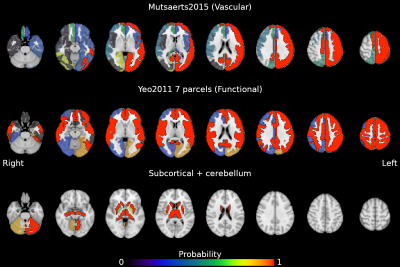 |
Long-term stability of cerebrovascular reactivity varies across brain regions
Stefano Moia1,2, Vicente Ferrer1,2, Rachael C Stickland3, Ross Davis Markello4, Eneko Uruñuela1,2, Maite Termenon1, César Caballero-Gaudes1, and Molly G Bright3,5
1Basque Center on Cognition, Brain and Language, Donostia, Spain, 2University of the Basque Country UPV/EHU, Donostia, Spain, 3Department of Physical Therapy and Human Movement Sciences, Feinberg School of Medicine, Northwestern University, Chicago, IL, United States, 4Montreal Neurological Institute, McGill University, Montreal, QC, Canada, 5Biomedical Engineering, McCormick School of Engineering and Applied Sciences, Northwestern University, Chicago, IL, United States
The reliability of cerebrovascular reactivity varies across brain regions, but little is known about what factors drive such variability. By leveraging a high-quality precision functional mapping dataset of breath-hold induced cerebrovascular reactivity (7 subjects with 10 sessions each), we assessed how much parcellations describing different architectures (i.e. vascular anatomy, functional networks, subcortical anatomy) could present internal homogeneity, and hence explain these regionally-specific reliability. We found that all architectures taken into account can equally explain these spatial patterns of cerebrovascular reactivity.
|
|||
3396.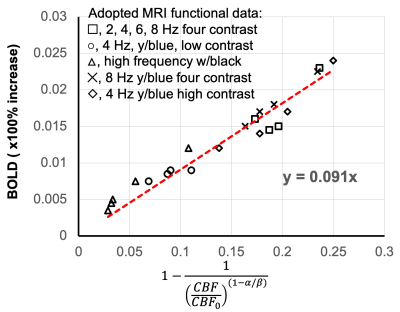 |
Non-calibrated Equations for Quantification of Local fMRI Signal Changes with Hemodynamic Oxygen Metabolism (CBF and CMRO2)
Linqing Li1, Sean Marrett1, Andy John Derbyshire1, and Peter Bandettini 2
1Functional MRI Facility/NIMH, National Institutes of Health, Bethesda, MD, United States, 2National Institute of Mental Health, National Institutes of Health, Bethesda, MD, United States Conventional CO2 calibration for quantification functional changes of CMRO2 may be sensitive to the experimental conditions. We derive a nonlinear coupling relationship of CMRO2 and CBF as simple as (CMRO2/CMRO20)=(CBF/CBF0)0.25, when α=0.38, β=1.5, where M-value from calibration is not necessary, from Davis model. Nonlinearity between percentage changes of δ(CMRO2)=CMRO2/CMRO20-1 and δ(CBF)=CBF/CBF0-1, in our equation is shown comparable to two classical models. Calculations of δ(CMRO2), based on our equation, are approximately consistent with previous results from both PET and MRI. Additionally, we prove that when desired, M can be measured directly from BOLD and CBF functional changes instead of CO2 calibration. |
|||
3397.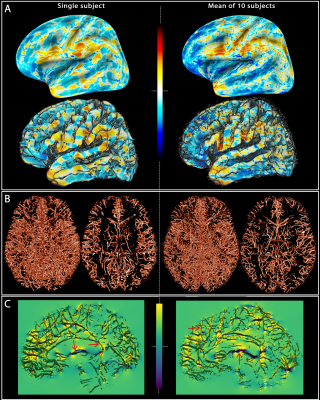 |
Modeling the vascular influences on BOLD fMRI using in vivo brain vasculature: incorporating vessel diameter, orientation, and susceptibility
Michael Bernier1,2, Jeorg Peter Pfannmoeller1,2, Saskia Bollmann3, Avery J.L. Berman1,2, and Jonathan R Polimeni1,2,4
1Department of Radiology, A. A. Martinos Center for Biomedical Imaging, Massachusetts General Hospital, Boston, MA, United States, 2Radiology, Harvard Medical School, Boston, MA, United States, 3Centre for Advanced Imaging, University of Queensland, Brisbane, Australia, 4Division of Health Sciences and Technology, Massachusetts Institute of Technology, Boston, MA, United States
We have developed a “forward-model” method to calculate the extravascular fields surrounding the blood vessels of the brain that accounts for the vessel diameter and orientation and estimates the field change with activation using in vivo measures of vessel anatomy and blood susceptibility.
|
|||
3398.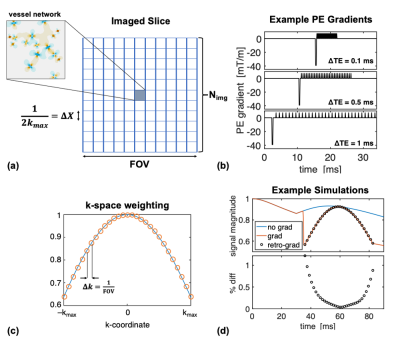 |
Biophysical simulations of the BOLD fMRI signal using realistic imaging gradients: Understanding macrovascular contamination in Spin-Echo EPI
Avery JL Berman1,2, Avery JL Berman1,2, Fuyixue Wang1,3, Kawin Setsompop4,5, J. Jean Chen6,7, and Jonathan R Polimeni1,2,3
1Athinoula A. Martinos Center for Biomedical Imaging, Massachusetts General Hospital, Charlestown, MA, United States, 2Department of Radiology, Harvard Medical School, Boston, MA, United States, 3Harvard-MIT Division of Health Sciences and Technology, Massachusetts Institute of Technology, Cambridge, MA, United States, 4Department of Radiology, Stanford University, Palo Alto, CA, United States, 5Department of Electrical Engineering, Stanford University, Palo Alto, CA, United States, 6Rotman Research Institute, Baycrest Health Sciences, Toronto, ON, Canada, 7Department of Medical Biophysics, University of Toronto, Toronto, ON, Canada
We introduce simulations of the BOLD signal that incorporate realistic image encoding gradients to help better understand the role the acquisition window plays on BOLD contrast. We applied this framework to examine the well-known macrovascular R2' contamination in spin-echo EPI BOLD signals as a function of readout duration, vessel diameter, and voxel size using randomly oriented cylinders. To understand large-vessel effects, more realistic anatomy is needed; therefore, we added a large pial vein to random microvascular networks to systematically investigate macrovascular contamination along cortical depths and across columns. This framework reproduced experimentally established results related to the acquisition window duration.
|
|||
3399.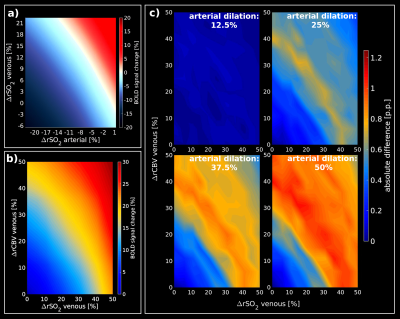 |
Numerical simulations to investigate the contribution of arteries and veins to the relative BOLD-fMRI signal change by means of SO2 and CBV changes
Mario Gilberto Baez-Yanez1, Alex Bhogal1, Wouter Schellekens1, Jeroen C.W. Siero1,2, and Natalia Petridou1
1Department of Radiology, Center for Image Sciences, University Medical Center Utrecht, Utrecht, Netherlands, 2Spinoza Centre for Neuroimaging Amsterdam, Amsterdam, Netherlands
The administration of CO2/O2 gas-challenges during BOLD-fMRI is appealing due to the hemodynamic impact these stimuli have. With the support of computational modeling, arterial gas manipulations can provide a means to separate neuro-vascular signal contributions. Hence, we performed simulations in virtual vascular architectures for different blood volumes and oxygen saturation levels. The effect that these states have on the magnetic field was simulated, separately, for arteries and veins. We present look-up tables to derive the possible vascular contribution responsible for measured BOLD signals in clinical or research fMRI settings including changes in local blood volume, oxygen metabolism or cereberovascular diseases.
|
|||
3400.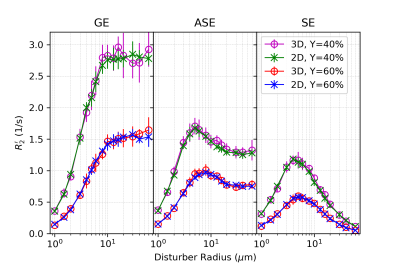 |
Simulating the BOLD fMRI transverse relaxation at 3 T: How accurate is the 2D approximation?
Jacob Chausse1, Avery J. L. Berman2, and J. Jean Chen1,3
1Rotman Research Institute, Baycrest Health Sciences, North York, ON, Canada, 2A. A. Martinos Center for Biomedical Imaging, Harvard Medical School, Massachusetts General Hospital, Boston, MA, United States, 3Department of Medical Biophysics, University of Toronto, Toronto, ON, Canada
Biophysical simulations of the BOLD fMRI phenomenon are indispensable for the development of quantitative fMRI techniques. Since the “gold-standard” 3D Monte Carlo simulation approach was proposed, 2D variations that are less computationally intensive have also been suggested. However, these approaches have never been directly compared. In this work, we directly compare the accuracy of 2D approaches against 3D ones, in order to reconcile results from different simulation studies.
|
The International Society for Magnetic Resonance in Medicine is accredited by the Accreditation Council for Continuing Medical Education to provide continuing medical education for physicians.